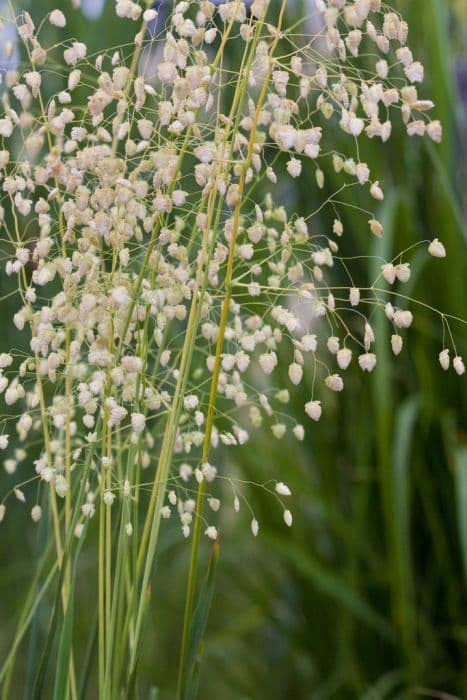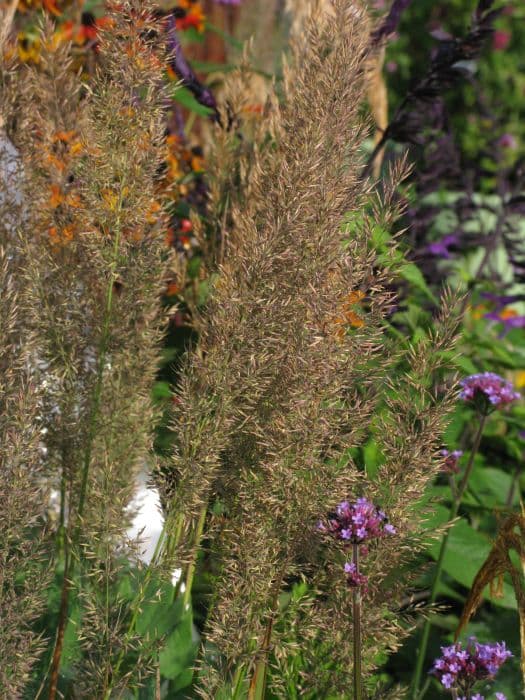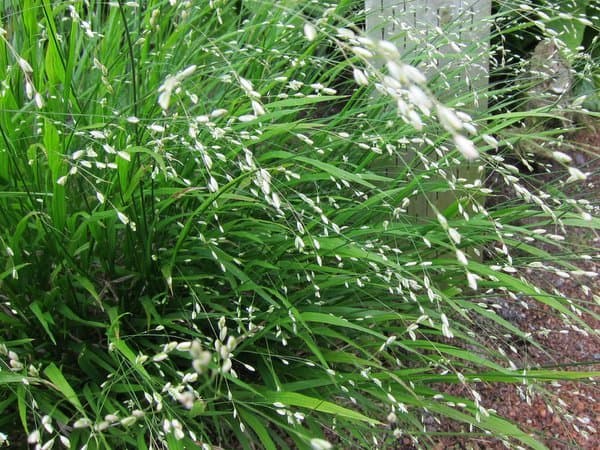Deschampsia cespitosa 'Goldschleier'

ABOUT
The Tufted Hair Grass 'Goldschleier' is a perennial grass known for its graceful and airy texture. It boasts mounds of narrow, fine leaves that have a deep green color, creating a dense tussock. During the warmer months, this variety produces feathery flower panicles that have a shimmering gold hue, lending the plant its name 'Goldschleier', which means 'gold veil' in German. The blooms rise elegantly above the foliage on slender stems, swaying gracefully in the breeze. This ornamental grass is distinguished by the delicate and subtle beauty of its seed heads, which persist into the autumn and even into the winter, providing visual interest throughout the year. The overall shape of the Tufted Hair Grass 'Goldschleier' is clump-forming, which gives it a neat appearance that works well in various garden settings.
About this plant
 Names
NamesFamily
Poaceae
Synonyms
Tufted Hair Grass, Gold Veil Tufted Hair Grass, Golden Dew Grass
Common names
Deschampsia cespitosa 'Goldschleier'.
 Toxicity
ToxicityTo humans
Tufted Hairgrass is not commonly listed as a toxic plant to humans. There are no well-documented cases or sources that indicate significant toxicity associated with this grass. Therefore, if ingested, Tufted Hairgrass is not expected to cause poisoning or serious symptoms in humans. However, incidental ingestion of any plant material may cause mild stomach upset in some individuals due to the fiber content or personal sensitivities.
To pets
Tufted Hairgrass is also not commonly listed as a toxic plant to pets. There does not appear to be any significant risk of poisoning or serious illness to pets such as dogs and cats from ingesting this grass. While it is not expected to cause any severe symptoms, ingestion of plant material can sometimes result in mild gastrointestinal upset, such as vomiting or diarrhea, particularly in animals with sensitive stomachs or those that are not accustomed to eating plant material.
 Characteristics
CharacteristicsLife cycle
Perennials
Foliage type
Evergreen
Color of leaves
Green
Flower color
Gold
Height
2 feet (60 cm)
Spread
1 foot (30 cm)
Plant type
Herb
Hardiness zones
4
Native area
Europe
Benefits
 General Benefits
General Benefits- Erosion Control: Helps stabilize soil and prevent erosion due to dense root systems.
- Habitat for Wildlife: Provides cover and nesting sites for birds and insects.
- Aesthetics: Adds visual interest to gardens with its golden foliage and airy flower panicles.
- Drought Tolerance: Once established, it is relatively drought-resistant, reducing the need for frequent watering.
- Low Maintenance: Requires minimal care beyond initial planting and occasional trimming.
- Cold Hardy: Can survive in cold winter climates, making it a suitable choice for northern gardens.
- Adaptability: Thrives in a wide range of soil types, including poor soils.
- Year-Round Interest: Provides visual interest throughout all seasons with evergreen or semi-evergreen foliage in milder climates.
- Non-Invasive: Unlike some grasses, it is generally not considered invasive, making it a responsible landscaping choice.
 Medical Properties
Medical PropertiesThis plant is not used for medical purposes.
 Air-purifying Qualities
Air-purifying QualitiesThis plant is not specifically known for air purifying qualities.
 Other Uses
Other Uses- Tufted Hairgrass 'Goldschleier' can be used in artistic landscape photography, its unique texture and coloration providing a different visual aspect throughout the seasons.
- The plant serves as an educational tool in botanical and horticultural studies, offering insight into the growth habits and characteristics of ornamental grasses.
- Tufted Hairgrass 'Goldschleier' may be incorporated into green roofs or living walls where its hardiness and low maintenance make it a suitable option for vertical gardening.
- The dense growth habit of Tufted Hairgrass 'Goldschleier' provides erosion control on slopes and banks, helping to stabilize soil and prevent landslides.
- It can be used as a natural dye source, the foliage producing subtle coloring for fabrics and yarns.
- Tufted Hairgrass 'Goldschleier' is sometimes used in sound barrier plantings due to its density, which can help to dampen noise pollution.
- This grass can play a role in biotope aquariums, providing a simulation of a grassy habitat for certain species of freshwater fish and invertebrates.
- Used in floristry as a dried plant, Tufted Hairgrass 'Goldschleier' adds structure and interest to floral arrangements and wreaths.
- In wildlife gardens, it provides habitat and food for a variety of insects, birds, and small mammals, contributing to biodiversity.
- As an ornamental plant in winter gardens, Tufted Hairgrass 'Goldschleier' maintains visual appeal even in off-season with its frost-touched foliage.
Interesting Facts
 Feng Shui
Feng ShuiTufted hairgrass is not used in Feng Shui practice.
 Zodiac Sign Compitability
Zodiac Sign CompitabilityTufted hairgrass is not used in astrology practice.
 Plant Symbolism
Plant Symbolism- Resilience: Deschampsia cespitosa 'Goldschleier', commonly known as Tufted Hair Grass, often symbolizes resilience as it can thrive in various conditions and withstand harsh environments.
- Grace: The delicate and fine structure of the grass blades and its graceful movement in the breeze bring to mind the quality of gracefulness.
- Growth: As a perennial plant, Tufted Hair Grass symbolizes continual growth and the cycle of life.
- Peace: The soft, feathery appearance of this grass’ seed heads can evoke a sense of calm and peace.
- Harmony: The way Tufted Hair Grass sways in unison with the wind can represent harmony with nature.
 Water
WaterTufted Hair Grass should be watered deeply to establish a strong root system, but once established, it is quite drought-tolerant. It is best to water this grass once a week with about one inch of water, ensuring the water penetrates the soil deeply. During particularly hot or dry periods, you may need to water twice a week, but always check the soil moisture first; it should be moist but not waterlogged. Proper drainage is crucial to prevent root rot. Reduce watering in the winter when the plant's growth slows down.
 Light
LightTufted Hair Grass thrives in full sun to partial shade conditions. Ideally, it should be placed in a spot where it can receive at least four to six hours of sunlight a day. If you live in a particularly hot climate, some afternoon shade will help protect the plant from excessive heat. Avoid deep shade, as this can lead to poor growth and reduced flowering.
 Temperature
TemperatureTufted Hair Grass is hardy and can tolerate a wide range of temperatures, generally thriving in conditions between 60°F and 75°F. While it can survive temperatures as low as -20°F, it's important to provide mulch for insulation during the colder months. High temperatures above 90°F can stress the plant, so some shade and ample watering during hot summers are beneficial.
 Pruning
PruningTufted Hair Grass benefits from periodic pruning to remove dead or discolored foliage and maintain a tidy appearance. Prune in the late winter or early spring before new growth starts, cutting back the old foliage to about 3-4 inches above ground. This can be done annually, depending on the plant's condition and your aesthetic preference. The best time for pruning is just as the snow melts or soil thaws, depending on your local climate.
 Cleaning
CleaningAs needed
 Soil
SoilTufted Hair Grass prefers well-draining soil with a slightly acidic to neutral pH of 5.5 to 7. The best soil mix would be a combination of loam, sand, and peat to ensure adequate drainage and fertility. It's crucial to avoid soil that retains too much moisture to prevent root rot.
 Repotting
RepottingTufted Hair Grass generally does not require frequent repotting. Repot once every 2 to 3 years, or when it outgrows its current pot, to freshen the soil and allow for more room to grow.
 Humidity & Misting
Humidity & MistingTufted Hair Grass tolerates a wide range of humidity conditions and does well in average ambient humidity. It is adaptable to both humid and drier environments, so specific humidity adjustments are typically not necessary for this grass.
 Suitable locations
Suitable locationsIndoor
Ensure bright light, cool temps, and airflow.
Outdoor
Plant in full sun, well-drained soil.
Hardiness zone
4-9 USDA
 Life cycle
Life cycleTufted Hair Grass 'Goldschleier' starts its journey as a seed, which, upon finding the right conditions of moisture and temperature, germinates to produce a small seedling. As it grows, this cool-season clump-forming perennial establishes a dense tussock of narrow, arching green leaves, which persist through the year. In the right conditions, it can spread through short rhizomes, but typically it forms clumps. During its flowering stage, usually in late spring or early summer, it sends up tall, airy panicles of golden flowers which can catch the light and add visual interest to gardens. After pollination, these flowers set seed, which can drop to the ground and germinate to produce new plants, thus continuing the cycle. In late autumn or winter, the plant's foliage might die back, especially in colder climates, but the roots remain alive and the grass will regenerate in the spring.
 Propogation
PropogationPropogation time
Early Spring
Propogation: Deschampsia cespitosa 'Goldschleier', commonly known as Tufted Hair Grass, is best propagated through division, ideally performed in the spring. To propagate by division, carefully lift the parent plant from the ground with a garden fork, minimizing root damage. Once the clump is removed, shake off excess soil and gently tease apart the plant segments, ensuring each division has a good amount of roots attached. These divisions can then be replanted in prepared soil, spacing them about 12 inches (approximately 30 centimeters) apart to allow for growth. Water the newly planted divisions thoroughly to help establish their root system. Division is not only a way to propagate new plants but also helps to rejuvenate older clumps that may have started to die out in the center.









